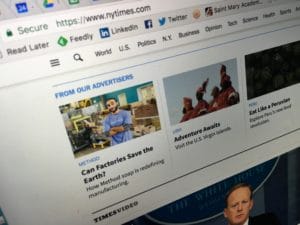My recent projects include several that focus on native advertising. Studying this emerging segment of digital marketing more closely has uncovered some surprises for me in how the market is using and responding to the opportunities.
To level-set, native advertising is known by many names. It’s often called sponsored content, advertorial, sponsored posts and the like. By native advertising, I mean content that blends into the main content of a website or social feed that looks and functions just like the main content, but is, in fact, paid for and focused on accomplishing something for an advertiser.
 My recent posts in partnership with Microsoft are an example here. Microsoft knows my audience consists of digital marketers and small business owners. Those audiences are ones it wanted to reach with its Office 365 white papers. The Federal Trade Commission requires me (and Microsoft) to disclose somewhere in the post that it is sponsored. (The post you are reading now is not. I’m using my Microsoft partnership as an example.)
My recent posts in partnership with Microsoft are an example here. Microsoft knows my audience consists of digital marketers and small business owners. Those audiences are ones it wanted to reach with its Office 365 white papers. The Federal Trade Commission requires me (and Microsoft) to disclose somewhere in the post that it is sponsored. (The post you are reading now is not. I’m using my Microsoft partnership as an example.)
But Native Advertising is far more popular and widespread than digital marketing blogs. Most major news organizations, which have built hundreds of thousands to even millions of readers on their websites, offer up native advertising spots. That’s right! Want to be featured on Huffington Post? Maybe Inc., magazine? How about on the New York Times?
If you’ve got the money, honey, you’ve got The Times.
So yes, you can write a story about your company, brand or event and get it published (with disclosure) on credible media outlets. And for you public and media relations professionals, isn’t that the greatest thing ever? (Okay, it costs money where the old way of doing it — and doing it well — didn’t require the payment or the disclosure. But you can just dial up a placement in The Times? Woah?!)
Even on a local level, Native Advertising is becoming a popular advertising product. I’ve surveyed the local options in Louisville, Ky., recently and for anywhere from $800 to $1600 per post, companies are manufacturing editorial on the trusted news sources in town.
As you would expect, there are good ways and bad ways, right ways and wrong ways, to use Native Advertising. It’s an effective method to accomplish certain communications, marketing and business goals, but not as effective to achieve some others. Here are my observations after studying Native Advertising for a bit.
Native Advertising is Great for Communications
The most effective strategies for Native Advertising fall in the issues management category of communications. Seeding content in the marketplace that helps brand your company, its leadership or persuade the public to think a certain way about you is where Native Advertising can pay great dividends.
Want to establish thought leadership in your category or for your executives? Use Native Advertising to seed smart articles by your executives offering up analysis of issues. Want to position your company as a great place to work for recruiting purposes? Profile your work culture or share ideas on how to foster great employee relations with Native Advertising posts. Need to mitigate the public perception over your company as it relates to a particular issue? Reinforce that stance with a Native Advertising campaign.
Native Advertising is not Great for Direct Response Advertising
The reason sponsored content is great for communications is the reason it’s not great for direct response advertising. Because a good Native Advertising program cannot be a one-off post. You need three, six, 10 posts over time to consistently reinforce the message before it truly takes hold. If you wish to change local political perception of your company with regard to a tax issue? You run 4-5 articles over a month or two. One article isn’t going to cut it.
It’s not unlike mainstream advertising. The most successful campaigns are such because of repetition. Trust me, you wouldn’t know how to spell O-S-C-A-R M-A-Y-E-R B-O-L-O-G-N-A if they’d run the commercial once.
The problem I see with how brand approach Native Advertising today is they think they’ll try one post and see how it does. I can tell you right now it’s not going to give you the metrics you want. It’s going to fail. You’re going to quit.
But if you run a 3-5-10 post campaign with a focused goal in changing attitudes or behavior about your company and build strong, interesting content that pushes people to think that way, then measure the change in attitudes and behavior (not how many things you sold), you’ll see the value.
The question then is whether the investment you have to make is worth the value you get in return.
Have You Tried Native Advertising?
While few brands overall have dipped their toes into Native Advertising there are some out there. If you’re one of them, I’d love to hear your experiences. This emerging method of engaging consumers and persuading audiences is ripe for innovation and opportunity. Share your stories of experimenting with us in the comments and let’s all learn together.
For more information about Native Advertising, I recommend exploring the topic at the Native Advertising Institute.

